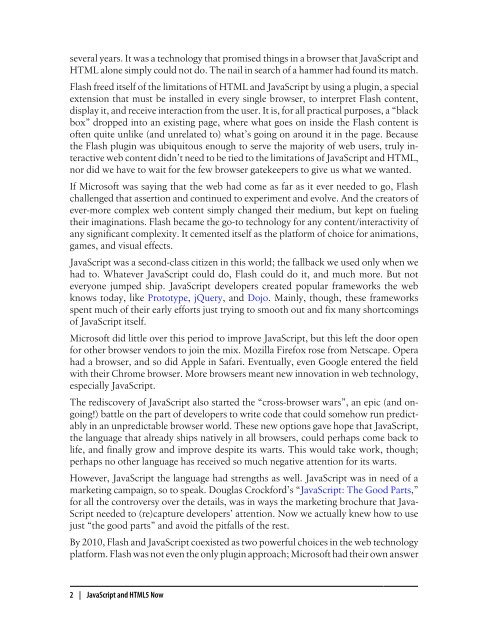JavaScript and HTML5 Now Kyle Simpson
JavaScript and HTML5 Now Kyle Simpson
JavaScript and HTML5 Now Kyle Simpson
You also want an ePaper? Increase the reach of your titles
YUMPU automatically turns print PDFs into web optimized ePapers that Google loves.
several years. It was a technology that promised things in a browser that <strong>JavaScript</strong> <strong>and</strong><br />
HTML alone simply could not do. The nail in search of a hammer had found its match.<br />
Flash freed itself of the limitations of HTML <strong>and</strong> <strong>JavaScript</strong> by using a plugin, a special<br />
extension that must be installed in every single browser, to interpret Flash content,<br />
display it, <strong>and</strong> receive interaction from the user. It is, for all practical purposes, a “black<br />
box” dropped into an existing page, where what goes on inside the Flash content is<br />
often quite unlike (<strong>and</strong> unrelated to) what’s going on around it in the page. Because<br />
the Flash plugin was ubiquitous enough to serve the majority of web users, truly interactive<br />
web content didn’t need to be tied to the limitations of <strong>JavaScript</strong> <strong>and</strong> HTML,<br />
nor did we have to wait for the few browser gatekeepers to give us what we wanted.<br />
If Microsoft was saying that the web had come as far as it ever needed to go, Flash<br />
challenged that assertion <strong>and</strong> continued to experiment <strong>and</strong> evolve. And the creators of<br />
ever-more complex web content simply changed their medium, but kept on fueling<br />
their imaginations. Flash became the go-to technology for any content/interactivity of<br />
any significant complexity. It cemented itself as the platform of choice for animations,<br />
games, <strong>and</strong> visual effects.<br />
<strong>JavaScript</strong> was a second-class citizen in this world; the fallback we used only when we<br />
had to. Whatever <strong>JavaScript</strong> could do, Flash could do it, <strong>and</strong> much more. But not<br />
everyone jumped ship. <strong>JavaScript</strong> developers created popular frameworks the web<br />
knows today, like Prototype, jQuery, <strong>and</strong> Dojo. Mainly, though, these frameworks<br />
spent much of their early efforts just trying to smooth out <strong>and</strong> fix many shortcomings<br />
of <strong>JavaScript</strong> itself.<br />
Microsoft did little over this period to improve <strong>JavaScript</strong>, but this left the door open<br />
for other browser vendors to join the mix. Mozilla Firefox rose from Netscape. Opera<br />
had a browser, <strong>and</strong> so did Apple in Safari. Eventually, even Google entered the field<br />
with their Chrome browser. More browsers meant new innovation in web technology,<br />
especially <strong>JavaScript</strong>.<br />
The rediscovery of <strong>JavaScript</strong> also started the “cross-browser wars”, an epic (<strong>and</strong> ongoing!)<br />
battle on the part of developers to write code that could somehow run predictably<br />
in an unpredictable browser world. These new options gave hope that <strong>JavaScript</strong>,<br />
the language that already ships natively in all browsers, could perhaps come back to<br />
life, <strong>and</strong> finally grow <strong>and</strong> improve despite its warts. This would take work, though;<br />
perhaps no other language has received so much negative attention for its warts.<br />
However, <strong>JavaScript</strong> the language had strengths as well. <strong>JavaScript</strong> was in need of a<br />
marketing campaign, so to speak. Douglas Crockford’s “<strong>JavaScript</strong>: The Good Parts,”<br />
for all the controversy over the details, was in ways the marketing brochure that Java-<br />
Script needed to (re)capture developers’ attention. <strong>Now</strong> we actually knew how to use<br />
just “the good parts” <strong>and</strong> avoid the pitfalls of the rest.<br />
By 2010, Flash <strong>and</strong> <strong>JavaScript</strong> coexisted as two powerful choices in the web technology<br />
platform. Flash was not even the only plugin approach; Microsoft had their own answer<br />
2 | <strong>JavaScript</strong> <strong>and</strong> <strong>HTML5</strong> <strong>Now</strong>


